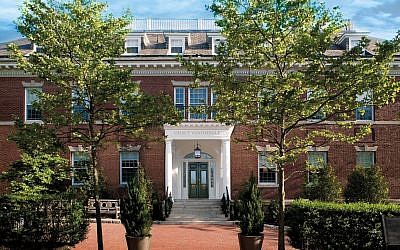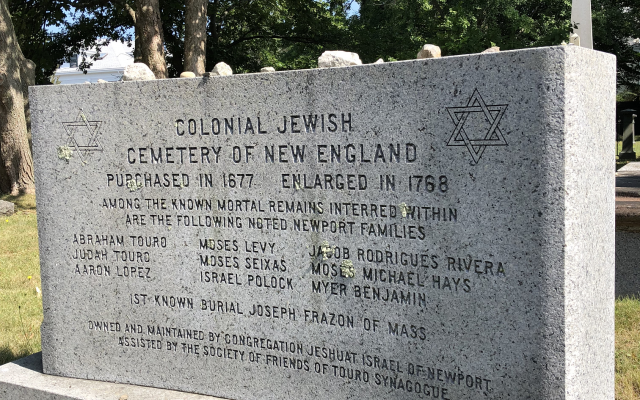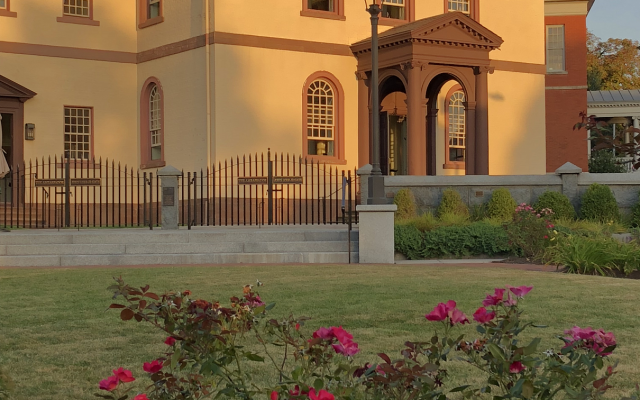A Trip to Newport and Colonial Jewish History
Robyn Spizman Gerson is a New York Times bestselling author and a media personality seen often on local and national television.
Robyn Spizman Gerson is a New York Times best-selling author of many books, including “When Words Matter Most.” She is also a communications professional and well-known media personality, having appeared often locally on “Atlanta and Company” and nationally on NBC’s “Today” show. For more information go to www.robynspizman.com.
It’s our good fortune to live in a country where beauty surrounds us. Unparalleled in history, Newport, R.I. is a good example. Our travels began in Marblehead, Mass., visiting family, passing through the oceanside cities north of Boston including Salem, Gloucester and Essex, and then a two-day trip by car to the nearby remarkable historical city of Newport.
A step back in time to Jewish Colonial history, Newport’s cobblestone streets and meticulously manicured streets were overflowing with historical points of interest. Visiting the famous Touro Synagogue, the nation’s oldest still-standing synagogue, was certainly a highlight. An amazing tale of freedom, faith and tolerance of all religions, the synagogue and its story embody the American Jewish experience.
Newport, a ship-filled harbor town, is also famously lined with the summer “cottages” of the wealthiest families in the history of our country. From the Vanderbilts to the Hunts, these mansions, by all standards, lived up to their opulent reputations.
We began our tour with a scenic Viking Tours trolley ride, an organized 90-minute tour on wheels featuring 150 points of interest, including the Jewish synagogue and cemetery. Next, we visited the famous cottages: from The Breakers, to Marble House, The Elms and Rosecliff, each with its own larger-than-life story of fortune and status-obsessed families. All ominous homes in their own rights, the tree-lined Bellevue Avenue, where they majestically lined up, was breathtaking. The dedicated Preservation Society of Newport County has captured history on all fronts, in a timeless era filled with philanthropy and quite a few generational scandals.

As Newport lodging would have it, our hotel was rooted in history and called the Grace Vanderbilt. The historic boutique hotel in Newport was minutes from the vibrant waterfront. Ideally located, it is one of the few private homes of the era to operate for guests as a full-functioning, top luxury hotel. Its warm atmosphere made you feel right at home with a highly attentive staff. Equipped with a delicious restaurant, luxury spa, pool and rooftop bar, its ambiance was stylishly and yet elegantly casual with attention to details, from concierge services to dining options and lodging accommodations that exude comfort. The Grace Vanderbilt certainly lives up to the Newport tradition of historic beauty.
Jewish History in The Making
Next, we were off to explore the vibrant history of Jewish Newport. The area received its first Jewish residents in the 17th century, possibly as early as 1658. The earliest-known Jewish settlers arrived from Barbados, where a Jewish community we visited last winter had existed since the 1620s.
Our tour of the Touro Synagogue, just a few blocks from our hotel, was memorable. Built to reflect the great synagogue in Amsterdam, it was designated a National Historic Site in 1946. The Friends of Touro Synagogue (now the Touro Synagogue Foundation) was established two years later to aid in its maintenance as well as to raise funds for and publicize the history.

A Letter from George Washington
While the story of the Jewish immigration to Newport is historically recorded and described in detail during the synagogue tour, one of the most notable pieces of American Jewish history revolves around President George Washington.
In 1790, Washington wrote one of the most important documents in history addressing freedom of religion and speech. Each year, the Touro Synagogue holds a public reading of the first president’s letter to the congregation as a celebration and pronouncement of religious freedom.
In 1789, Washington, in his first presidency, decided to tour the New England states, but didn’t visit Rhode Island. In August 1790, Washington chose to pay a good-will visit to Newport for a public appearance to rally support for the new Bill of Rights. He took with him Secretary of State Thomas Jefferson and New York Gov. George Clinton. On Aug. 18, 1790, officials and notables from various religious groups read the president’s letters of welcome. Among them was one of the leaders of the congregation, Moses Seixas, who read the letter aloud. Seixas poured out his gratitude to Washington for his leadership of a new government. He expressed the hope that his new country would welcome all citizens with tolerance and respect, regardless of their religious beliefs.
The letter moved President Washington and he responded on Aug. 21, 1790, assuring the Hebrew congregation that “everyone shall sit in safety under his own vine and fig tree, and there shall be none to make him afraid.” He also wrote that this would be a country that “gives to bigotry no sanction.”
Experts say he was paving the way for the First Amendment, which would be added to the Constitution on Dec. 15, 1791.
Building the Synagogue
Near the synagogue, behind a brick wall is a private Jewish cemetery filled with century-old trees in which some of the early founders were buried. “By 1677, the community realized the need to acquire land for a Jewish cemetery. Two of the original immigrants, Mordechai Campanal and Moses Pacheco, purchased the lot at the corner of what is now Kay and Touro Streets for this purpose,” according to the historic synagogue’s website.

Through the early and middle 1700s, Newport grew its role in the shipping and mercantile trades of the American colonies. By 1758, the Jewish population had grown and there was a need for a house of worship. The congregation now known as Congregation Jeshuat Israel engaged Newport resident Peter Harrison to design the synagogue, and construction began in 1759.
Harrison drew on his knowledge of Palladian architecture for the exterior. He is credited with being one of the first to bring this European architectural style to the American colonies. For the interior, his best references came from congregation hazzan Isaac Touro, who had recently arrived from Amsterdam, and it was modeled in the style of the synagogue there.
The building was completed in 1763 and dedicated during the Chanukah festival celebrations. Newport natives Abraham and Judah Touro, sons of Isaac Touro, later both provided bequests to see to the perpetual care of the congregation’s properties.
Today, the synagogue remains an active house of worship toured annually by thousands of visitors.
If you get the chance to attend services at the synagogue, you should. We went to a daily minyan service and engrossed ourselves in this Orthodox synagogue.
As the final excursion during our 48 hours in Newport, we took the advice of the city’s experts and signed up for an afternoon sail boat tour run by Classic Cruises of Newport. We chose the classic schooner Madeleine, sailing past the ocean-lined mansions and discovering a new view of Newport. With the sights and sounds of sea gulls, we saw from a distance the summer home of 24-year-old Jacqueline Bouvier who married John F. Kennedy on Sept. 12, 1953, in Newport.
A touch of Camelot was the ideal way to bid farewell to this timeless seaside setting and rich historical world of generations past.




comments